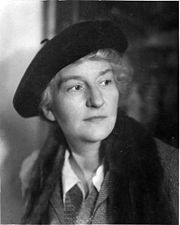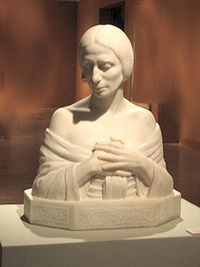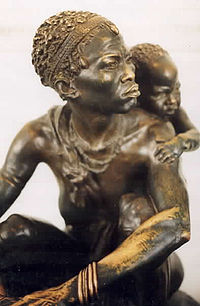
Malvina Hoffman
Encyclopedia

Sculpture
Sculpture is three-dimensional artwork created by shaping or combining hard materials—typically stone such as marble—or metal, glass, or wood. Softer materials can also be used, such as clay, textiles, plastics, polymers and softer metals...
and author
Author
An author is broadly defined as "the person who originates or gives existence to anything" and that authorship determines responsibility for what is created. Narrowly defined, an author is the originator of any written work.-Legal significance:...
, well known for her life-size bronze sculptures of people. She also worked in plaster and marble.
Stanley Field, director of the Field Museum of Natural History
Field Museum of Natural History
The Field Museum of Natural History is located in Chicago, Illinois, USA. It sits on Lake Shore Drive next to Lake Michigan, part of a scenic complex known as the Museum Campus Chicago...
in Chicago, commissioned Hoffman to create sculptures of people representing members of the diverse groups of humans in culture
Culture
Culture is a term that has many different inter-related meanings. For example, in 1952, Alfred Kroeber and Clyde Kluckhohn compiled a list of 164 definitions of "culture" in Culture: A Critical Review of Concepts and Definitions...
s around the world that became a permanent exhibition at the museum entitled "Hall of the Races of Mankind", which was popular for both for its artistic and cultural values. It was featured at the Century of Progress International Exposition
Century of Progress
A Century of Progress International Exposition was the name of a World's Fair held in Chicago from 1933 to 1934 to celebrate the city's centennial. The theme of the fair was technological innovation...
, the Chicago World's Fair of 1933 that celebrated the centennial of the city. The museum also published a Map of Mankind, featuring her sculptures in a border surrounding a map of the world that was distributed widely with an informative, large-format booklet that made Hoffman's sculptures very well known.
Portrait busts of significant individuals of that time and depictions of people in their everyday lives were frequent works executed by Hoffman. Dancers were the subjects of the works that brought her earliest recognition and she continued to sculpt dancers throughout her career, some individuals repeatedly, such as Anna Pavlova. She was highly skilled in foundry techniques as well, often casting her own works and she published a definite work on historical and technical aspects of sculpture, Sculpture Inside and Out.
Biography

New York City
New York is the most populous city in the United States and the center of the New York Metropolitan Area, one of the most populous metropolitan areas in the world. New York exerts a significant impact upon global commerce, finance, media, art, fashion, research, technology, education, and...
, the daughter of the concert pianist
Pianist
A pianist is a musician who plays the piano. A professional pianist can perform solo pieces, play with an ensemble or orchestra, or accompany one or more singers, solo instrumentalists, or other performers.-Choice of genres:...
, Richard Hoffman. She gravitated toward sculpture at an early age, demonstrating her talents. By the age of fourteen she was taking classes at the Art Students League of New York
Art Students League of New York
The Art Students League of New York is an art school located on West 57th Street in New York City. The League has historically been known for its broad appeal to both amateurs and professional artists, and has maintained for over 130 years a tradition of offering reasonably priced classes on a...
. She later received help from the sculptors Herbert Adams, George Grey Barnard
George Grey Barnard
'George Grey Barnard was an American sculptor, "an excellent American sculptor", the French art dealer René Gimpel reported in his diary , "very much engrossed in carving himself a fortune out of the trade in works of art." His lasting monument, rather than any sculpture of his own, is the...
, and Gutzon Borglum
Gutzon Borglum
Gutzon de la Mothe Borglum was an American artist and sculptor famous for creating the monumental presidents' heads at Mount Rushmore, South Dakota, the famous carving on Stone Mountain near Atlanta, as well as other public works of art.- Background :The son of Mormon Danish immigrants, Gutzon...
, who was a friend of her family. Another family friend, Alexander Phimister Proctor
Alexander Phimister Proctor
Alexander Phimister Proctor was an American sculptor with the contemporary reputation as one of the nation's foremost animaliers.-Birth and early years:...
, allowed her the use of his MacDougal Alley studio for a summer.
In 1910 Hoffman moved to Europe at the age of twenty-three when her father died. Accompanying her mother, they first lived in Italy before moving to Paris
Paris
Paris is the capital and largest city in France, situated on the river Seine, in northern France, at the heart of the Île-de-France region...
. After several unsuccessful attempts, she eventually was accepted as a student by Auguste Rodin
Auguste Rodin
François-Auguste-René Rodin , known as Auguste Rodin , was a French sculptor. Although Rodin is generally considered the progenitor of modern sculpture, he did not set out to rebel against the past...
. He later convinced her to return to Manhattan
Manhattan
Manhattan is the oldest and the most densely populated of the five boroughs of New York City. Located primarily on the island of Manhattan at the mouth of the Hudson River, the boundaries of the borough are identical to those of New York County, an original county of the state of New York...
to spend a year dissecting bodies at the College of Physicians and Surgeons
Columbia University College of Physicians and Surgeons
Columbia University College of Physicians and Surgeons, often known as P&S, is a graduate school of Columbia University that is located on the health sciences campus in the Washington Heights neighborhood of Manhattan...
. The education she received there was invaluable, honing her remarkable skill of rendering anatomical features that was evidenced highly when she embarked on her ambitious project to sculpt the anthropological series.
While working for the Red Cross during and after World War I, Hoffman traveled to Yugoslavia
Yugoslavia
Yugoslavia refers to three political entities that existed successively on the western part of the Balkans during most of the 20th century....
where she first met sculptor Ivan Mestrovic
Ivan Meštrovic
Ivan Meštrović was a Croatian and Yugoslav sculptor and architect born in Vrpolje, Croatia...
, with whom she would study a decade later. She was commissioned to execute several war memorials following WWI, both domestically and internationally.
Anthropological series

Field Museum of Natural History
The Field Museum of Natural History is located in Chicago, Illinois, USA. It sits on Lake Shore Drive next to Lake Michigan, part of a scenic complex known as the Museum Campus Chicago...
in Chicago, Illinois, sculpting life-sized statues of members of the diverse human cultural groups and she eventually completed one hundred and five sculptures, including busts, full-length figures of individuals, and small family groups for the project. Her skill at representation of the human form allowed her to render the graceful beauty of her subjects during their daily activities. This project resulted in the largest single corpus of her work.
Initially, these sculptures were set up in the Hall of Man that was established at the museum. The stories of her trips to track down the various models for each cultural group form the basis of her first book, "Heads and Tales".
However, after 30 years of display, questions began to circulate regarding the relevance of the context in which the original display was exhibited. According to American Historical Review, "the sculptures in the "Races of Mankind" had perpetuated an older typological approach by presenting "race" in the form of literally static bronze figures depicting idealized racial "types.""(Brattain, 2007). The collection was dispersed around the museum, much of it being removed from public view and relegated to storage. The retention of the sculptures by the museum provides the potential for the redisplay of the figures, if an appropriate context were developed and agreed upon.
Many of a limited series cast of smaller versions of the Hoffman life-sized anthropological sculptures, Mankind, were purchased by well-known art collectors such as, Geraldine R. Dodge, however, so appreciation for her skill in this endeavor was not lost. Several were featured in an auction held at Dodge's New Jersey estate in the late 1970s and others remain held in other private collections.
Post-World War II

Vosges
Vosges is a French department, named after the local mountain range. It contains the hometown of Joan of Arc, Domrémy.-History:The Vosges department is one of the original 83 departments of France, created on February 9, 1790 during the French Revolution. It was made of territories that had been...
, France
France
The French Republic , The French Republic , The French Republic , (commonly known as France , is a unitary semi-presidential republic in Western Europe with several overseas territories and islands located on other continents and in the Indian, Pacific, and Atlantic oceans. Metropolitan France...
. This marks the site of bloody fighting that took place in December 1944, in what became known as, the Battle of the Bulge
Battle of the Bulge
The Battle of the Bulge was a major German offensive , launched toward the end of World War II through the densely forested Ardennes mountain region of Wallonia in Belgium, hence its French name , and France and...
.
In addition to her professional talents, it is likely that Hoffman was chosen as the sculptor for this project because of the very active role she had played in the Red Cross during both WWI and WWII. Her selection also is symbolically meaningful because, during their occupation of France, the Nazis deliberately destroyed several of her commemorative works that were located in Paris
Paris
Paris is the capital and largest city in France, situated on the river Seine, in northern France, at the heart of the Île-de-France region...
.
Some of her later commemorative monuments stand at Harvard University and Syracuse University as well as at locations in London and Paris. Many of her portraits of individuals are among the collection of the New York Historical Society. She maintained a salon
Salon (gathering)
A salon is a gathering of people under the roof of an inspiring host, held partly to amuse one another and partly to refine taste and increase their knowledge of the participants through conversation. These gatherings often consciously followed Horace's definition of the aims of poetry, "either to...
, a social gathering of artistic and personal acquaintances, at her Sniffen Court studio for many years.
Overview
Throughout her career, dancers fascinated Hoffman and they form the subject matter for many of her most well-known pieces although the anthropological works are the greatest in number for a single project. Many of her works were portrait busts: both of significant persons of the time and of working-class people she encountered in daily life. She often was commissioned to execute commemorative monuments and was awarded many prizes and honors. She was a member of the National Sculpture SocietyNational Sculpture Society
Founded in 1893, the National Sculpture Society was the first organization of professional sculptors formed in the United States. The purpose of the organization was to promote the welfare of American sculptors, although its founding members included several renowned architects. The founding...
.
She was married to Samuel B. Grimson, often known simply as S. B. Grimson, who traveled with her during her search for authentic indigenous
Indigenous peoples
Indigenous peoples are ethnic groups that are defined as indigenous according to one of the various definitions of the term, there is no universally accepted definition but most of which carry connotations of being the "original inhabitants" of a territory....
models for the anthropological series. Over 2,000 photographic negatives from that search are among the extensive documents of her career. Some are featured in her autobiographies.
In 1965 she published, Yesterday is Tomorrow, her final book. The next year, at the age of seventy-nine, Malvina Cornell Hoffman died while working in her studio in Manhattan
Manhattan
Manhattan is the oldest and the most densely populated of the five boroughs of New York City. Located primarily on the island of Manhattan at the mouth of the Hudson River, the boundaries of the borough are identical to those of New York County, an original county of the state of New York...
, which had been purchased for her early in her career by the philanthropist Mary Williamson Averell
Mary Williamson Averell
Mary Williamson Averell was born in New York City into a prominent New York family. The only daughter, she was tutored at home and completed her education at a finishing school with the “…expectation that one day she would become a fine wife and mother for some young man of equal or greater social...
.
Selected works
- Boy and Panther Cub, 1915 (Cedar Rapids, IA art museum)
- 105 figures for the Hall of Man, Field Museum of Natural History, Chicago, Illinois 1933
- Russian Dancers
- Bacchanale Russe
- Colonel Milan Pribicevic
- Ivan Mestrovic
- The Sacrifice, Cathedral of St. John the Divine, NY, NY
- Ignace Paderesski both as The Statesman and The Artist
- Column of Life
- Bill Working
- To the Friendship of English Speaking Peoples
- several statues of the Russian dancer Pavlova, solo and with partners
- Epinal American Cemetery and Memorial, Epinal, France 1958
External links
- Tribute to Malvina Hoffman
- Photo Archives - Malvina Hoffman Collection at the Field Museum
- Malvina Hoffman papers, 1897-1984. Research Library at the Getty Research Institute. Los Angeles, California. The collection comprises a virtually complete archive of papers relating to Hoffman’s life and career as a sculptor and writer. Correspondence traces Hoffman’s relationships with friends, such as Auguste Rodin, Ivan Mestrovic, Anna Pavlova, Jean Jacques Lemordant, Alexandre Iacovleff, and Marianne Moore, family members, and clients, as well as the development of her commissions and publications
- http://books.google.com/books?id=PHH45aYubp4C&pg=PA276&lpg=PA276&dq=malvina+hoffman+-+new+york&source=bl&ots=yajqLeRGjw&sig=QRRyo9juvuBLMBL5vTCkSrgwQTs&hl=en&ei=V_t1Suz2BZmMtgfMyt2WCQ&sa=X&oi=book_result&ct=result&resnum=2#v=onepage&q=malvina%20hoffman%20-%20new%20york&f=falseMalvina Cornell Hoffman entry, p. 276, Painting and Sculpture in the Collection of National Academy of Design, by David Bernard Dearinger]

